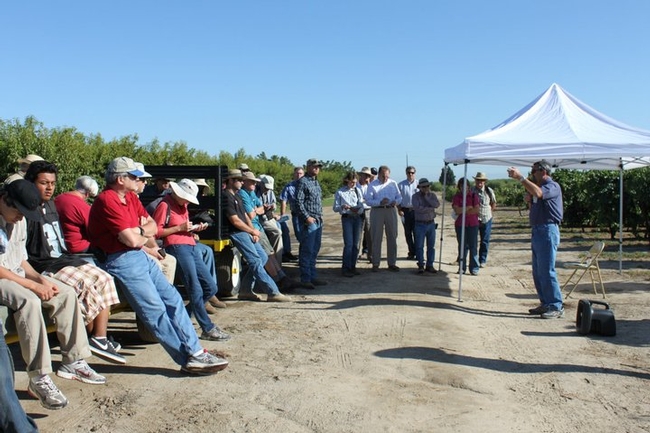Posts Tagged: grape
The Achemon Sphinx Moth: A Lovely Beast, Indeed
It is indeed a “lovely beast,” as lepidopterist Art Shapiro, UC Davis distinguished professor of evolution and ecology, ...
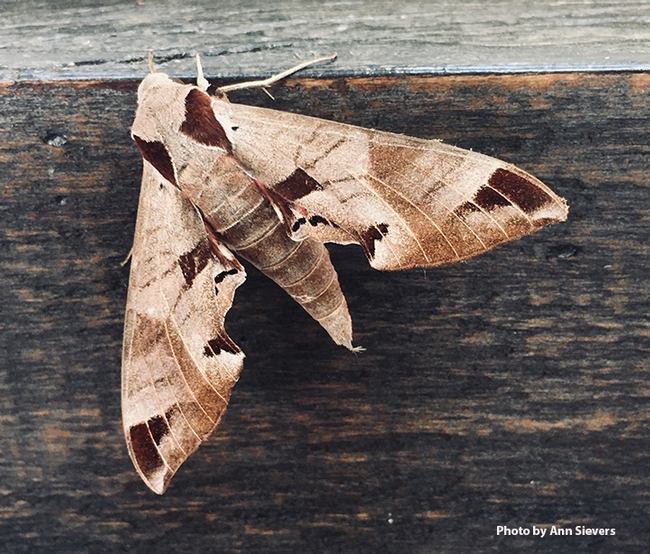
Eumorpha achemon, the Achemon Sphinx, is a "lovely beast," says UC Davis distinguished professor Art Shapiro. Ann Sievers, owner, grower and miller Il Fiorello Olive Oil Co., recently found this one the wall of her patio. (Photo by Ann Sievers)
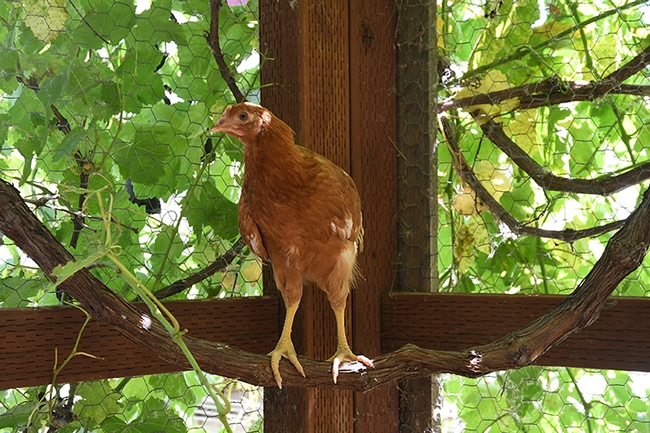
What's for lunch? A chicken in one of Ann Sievers' flocks at Il Fiorello Olive Oil Co., eyes the photographer. Chickens eagerly eat lots of bugs--if they're available. The larvae of the Achemon Sphinx moth feed on grape leaves. (Photo by Kathy Keatley Garvey)
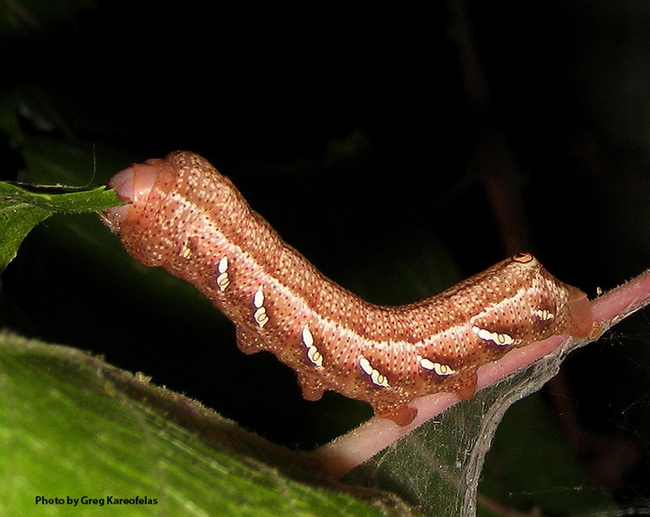
Naturalist-photographer Greg Kareofelas took this image of an Eumorpha achemon larva in his yard in Davis several years ago. It was feeding on native grape, Vitus californica. (Photo by Greg Kareofelas)
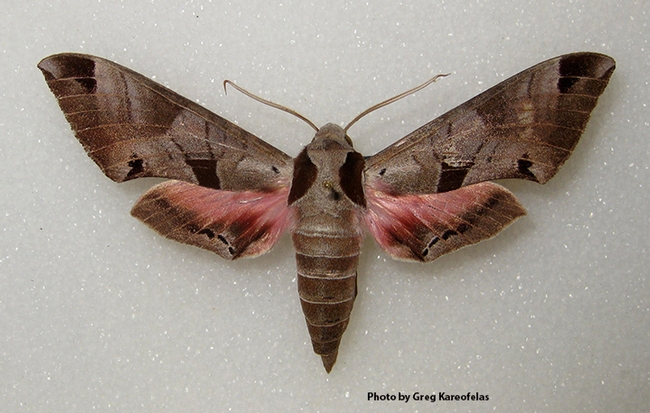
An adult Eumorpha achemon, photographed by naturalist-photographer Greg Kareofelas in his yard in Davis several years ago. It was feeding on native grape, Vitus californica. (Photo by Greg Kareofelas)
Rest Stop at the Arrol-Metz House
One of my favorite things in the garden is getting to watch the hummingbirds. I enjoy watching them travel from flower to flower, trying a little nectar here, and then a little nectar there. I love it when the sunlight reflects off their throat patch, giving it that ruby glow. I am impressed by their moxie. They don't seem afraid of creatures much larger than they are. I love their chirrupy call and the sound their wings make. I've been watching them for years, so I thought I'd seen pretty much everything ...
Until a few mornings ago, I went to my window and saw a hummingbird going from grape leaf to grape leaf. I was really puzzled as I knew there were not any flowers on the vine, and only two clusters of grapes on that vine. As I got closer I saw he was rubbing himself on the leaf, then ducking his head and throwing back his shoulders, all while his little wings were just whirring away. He did this on several leaves, before it finally dawned on me what was going on. The sprinklers had just finished running and the grape leaves were sheeted with water. The hummer was cleaning himself in the water on the leaves, and seemed to be having a grand time.
He also seems to think that the tomato cages have been put out for his convenience to perch on and rest in between checking out gladiola blossoms. Hey, I am always happy to be of service.
The Nose Knows
Ask any gardener what their favorite plant is and I bet you will find they can’t name just one. Count me in that group. I love plants. But there are a few stand-outs that are worth mentioning.
For me, what captures my interest is either the color or smell of a plant. I love bright colors. Mostly oranges and blues. But I think that fragrance is the top attribute I look for in plants to add to my yard.
When I was attending Cal Poly, San Luis Obispo, I learned of this plant called Psoralea pinnata also known as the Scurfy Pea or the Kool-Aid® Bush. I had never encountered such a plant before. This was way back when I was just getting in to Horticulture, I was a late-bloomer with respect to learning or loving plants! (yes, pun intended) What caught my attention is the smell of the flowers. They smelled like grape Kool-Aid®! Seriously! The plant is somewhat ugly and rangy, but the blue and white flowers made up for that.
Since then, I have found a prettier substitute for the Scurfy Pea. This plant is in one of my favorite genuses, Salvia. The plant is Salvia melissodora known as the Grape-scented sage. It is a shrub that can get to 8 feet tall. It is native to the upper elevations of Mexico. The leaves also have an interesting smell, but not as good as the grapey fragrance of the violet/lavender flowers. To enjoy the smell, you have to avoid bruising the leaves, so don’t touch, just sniff. But be careful, as the carpenter bees and other bees visit this plant frequently. You don’t want a sting on your sniffer!
I have two of these salvias planted just outside my window. In the warm evenings of the summer, you can smell their delightful grape scent as it perfumes the neighborhood and of course, inside my home.
I recommend you open up your senses and try picking out plants with interesting fragrances to add to your own yards. You’d be amazed at what’s out there.
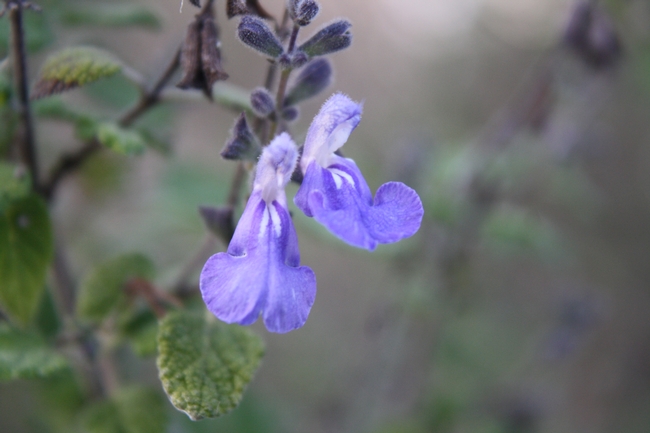
Grape-scented sage. (photo by Jennifer Baumbach)
Grape Turtles
The crape myrtles are blooming. Have you noticed? They’re pretty hard to miss, what with their beautiful blossoms in hot fuchsia, spicy red, pale lavender, pretty pink and clear white. These woody perennials thrive in Solano’s zones and offer year-round interest: peeling bark in winter and spring, blooms in summer, and fall leaf color.
I just stumbled across something I’d not realized about Lagerstroemia, the genus also known as crape myrtle. Not everyone spells it like that: CRAPE myrtle. Many spell it CREPE myrtle. Apparently, this is a long-running horticultural debate. Whether it’s spelled crape myrtle, crepe myrtle, crapemyrtle, crepemyrtle or crepe myrtles may simply be a geographical preference, or an evolution of language. In the U.S., the traditional Southern spelling is crepe myrtle (because the delicate flowers resemble crepe paper). Across the rest of the U.S. it is more commonly spelled crape myrtle, which is considered the French spelling. In Europe and Australia and other countries they use the scientific name, Lagerstroemia Crape Myrtle.
But I think my youngest child, Katie, has the best name for the shrubby little trees. As young as first grade, Katie noticed when Vacaville’s crape myrtles started to bloom. Knowing I love the beautiful colors, Katie would point them out: “Look, Mommy! The grape turtles are blooming!” Katie’s nearly 18 now and we still giggle when we notice summer’s explosion of crape myrtle blossoms.
Grape turtles indeed.

You say crape myrtle, I say grape turtle: Summer in Solano means the Lagerstroemia are in bloom. (photo by Kathy Thomas-Rico)
Kearney trial could reveal the next great white wine
San Francisco Chronicle wine columnist Jon Bonné wrote about the prospects for another variety of white wine to rise in popularity, perhaps to the level of such well known wines as Chardonnay, Sauvignon Blanc, Pinot Gris and Reisling. In the article, Bonné referenced a new trial at UC Kearney Agricultural Research and Extension Center, where 55 varieties are under study, from Trebbiano to Petit Manseng. The study was designed to determine what might best match the San Joaquin Valley's hot climes. Project leader UC Cooperative Extension viticulture specialist Jim Wolpert was intrigued by grapes from warm spots like Sicily, where Grillo and Carricante thrived in the heat. At the same time, he saw a flood of new varieties being made available by Davis' Foundation Plant Services, yet little interest from nurseries. An experiment was born. "I think there's a treasure trove of varieties there," Wolpert said. "All we need to find is a couple."
Proposed Green Tech High School Academy draws critics
Jennifer Bonnett, Lodi News Sentinel
Lodi Unified School District has proposed developing a Green Tech High School Academy, the first of its kind in California. The district has already spent hundreds of hours and thousands of dollars laying the groundwork for a new school that some trustees say they can’t support. Parent Paul Verdegaal called it the wrong idea at the wrong time. “It appears that LUSD is once again chasing pipe dreams at great cost in money and opportunities for students to actually learn, especially with reduced budgets," he said. The article noted that Verdegaal is a farm adviser for the University of California Cooperative Extension in San Joaquin County. Verdegaal said he sees students who don’t understand science or math, key subjects in creating sustainable practices.
This year's olive harvest is the pits
Martin Espinoza, The Press Democrat
Sonoma County olive growers are bracing for a disastrous harvest, one that could wipe out the supply of fresh local olive oil. Paul Vossen, a farm advisor with the University of California Cooperative Extension, said that in an average low-yield year olive orchards produce 50 to 60 percent less. “We have some places where they have almost nothing,” he said.


